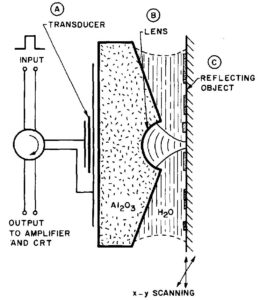 The heart of the scanning acoustic microscope is an acoustic lens (B), which focuses acoustic waves using a spherical cavity in a sapphire rod. Since the ratio of sound velocities in the sapphire rod and in the immersion medium (water) is very high, an aberration free and diffraction-limited focusing occurs even when the acoustic lens has a small f-number. The sound waves are created in the sapphire rod at GHz frequencies using a piezoelectric film (ZnO) sandwiched between two metal electrodes (A). The object to be imaged (C) is placed at the focus of the acoustic waves and mechanically scanned in a raster pattern.
The heart of the scanning acoustic microscope is an acoustic lens (B), which focuses acoustic waves using a spherical cavity in a sapphire rod. Since the ratio of sound velocities in the sapphire rod and in the immersion medium (water) is very high, an aberration free and diffraction-limited focusing occurs even when the acoustic lens has a small f-number. The sound waves are created in the sapphire rod at GHz frequencies using a piezoelectric film (ZnO) sandwiched between two metal electrodes (A). The object to be imaged (C) is placed at the focus of the acoustic waves and mechanically scanned in a raster pattern.
The focus size determines the resolution of the microscope, which may be less than the wavelength in the immersion medium. The resolution can be improved by increasing frequency. At 2 GHz, the resolution is better than 700 nm. Unfortunately, the nature limits the resolution: The attenuation in water increases very rapidly with increasing frequency. At 2 GHz the attenuation in water is 800 dB/mm. One has to use a very small lens to reduce the attenuation. Even with a focal length of 50 μm, two-way attenuation is in water is 80 dB.
The scanning acoustic microscope has the ability to image not just the surface, but also what is underneath the surface. The received signal is highly dependent the mechanical properties of the object.
